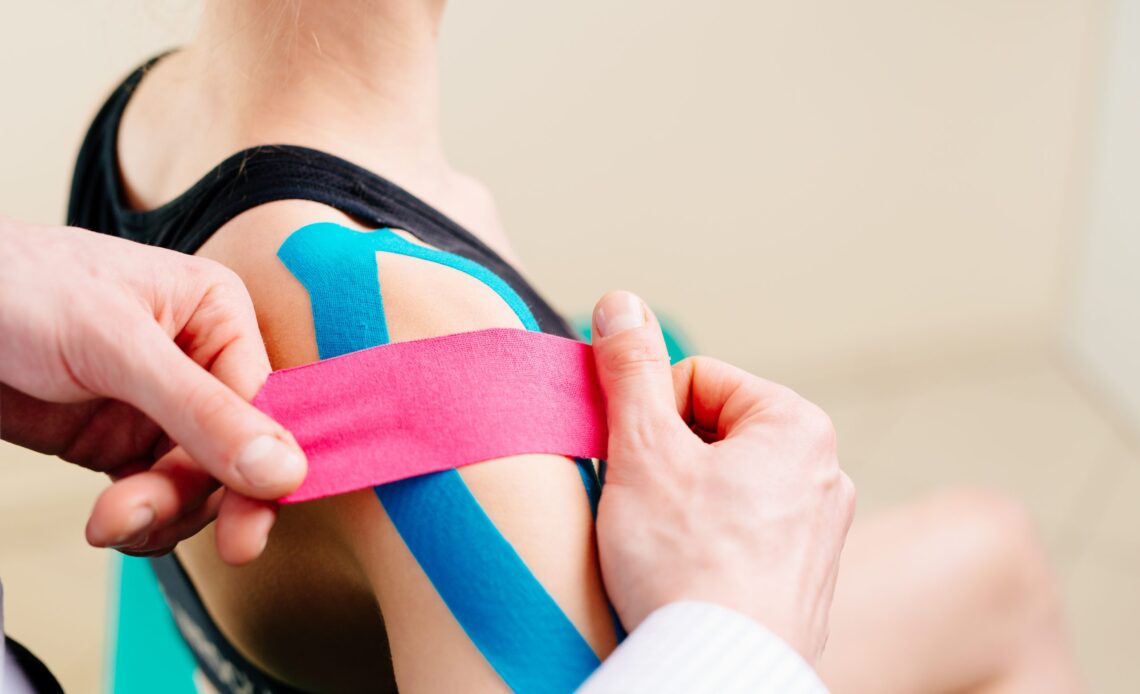
Since its first development in the 1970s, kinesiology tape has evolved dramatically and became increasingly popular among athletes, physicians and the general public. Many sports trainers and coaches now use taping to treat injuries and provide joint support for their athletes in- and off-season. Physicians have also found kinesiology taping beneficial for patients that suffer from cerebral palsy, arthritis, chronic back pain and more.
Are you interested to learn more about kinesiology tape? Here’s everything you need to know about taping.
What Does Kinesiology Tape Do?
When an injury or trauma occurs, the healing process begins with blood and other fluids rushing to the area to deliver oxygen, nutrients, and immune cells. This fluid build-up in the injury site often causes pain, swelling and redness, hence hindering many day-to-day activities.
This is where kinesiology tape can help.
Kinesiology tape is usually made with a cotton-nylon blend designed to mimic human skin elasticity and thickness. The tape’s elasticity is an important feature. When applied to the injured area, it recoils slightly and gently lifts the skin away from the tissues underneath to create a small space. This encourages lymphatic drainage, reduces swelling and alleviates pressure on local pain receptors. It also assists blood circulation, which, in turn, helps bruises heal and fade faster.
Kinesiology taping is an excellent alternative to athletic taping. Most patients find kinesiology tape to be much more comfortable as it provides adequate support without restricting the range of motion and circulation.
Some Proposed Benefits And Specific Uses Of Taping
- Relieving pain by reducing fluid pressure on peripheral nociceptors
- Reducing swelling by creating space for increased circulation
- Improving joint and muscle alignment by providing support
- Re-educating muscles through increasing proprioceptive sense
- Enhancing athletic performance by protecting against injury
- Reducing scar tissue after surgery or injury
When Not To Use Kinesiology Tape
Despite its many benefits, there are some circumstances when kinesiology cannot and should not be used, including:
- Open wounds, rashes or burns– taping can lead to infections or skin damage
- Latex allergies– make sure the tape is hypoallergenic before use
- Deep vein thrombosis– increased circulation can cause the blood clot to dislodge
- Active cancer– taping can increase blood supply to cancer growth
- Diabetes– patients with advanced diabetes can have reduced sensation and may not notice adverse reactions to taping
- Fragile skin– avoid taping skin prone to tearing due to medication, medical conditions or age
We recommend doing a 24-hour test patch on the patient’s skin if they are concerned about skin sensitivity.
Kinesiology Tape With Active Ingredients
Some companies offer kinesiology tape with additional ingredients in the adhesive to increase patient comfort during recovery. Camphor and menthol are commonly added to reduce pain by inactivating TRPA1 ion channels on pain receptors. Some other proposed benefits of kinesiology tape with active ingredients include:
- Dilating arterioles and capillaries
- Increasing blood circulation
- Relaxing muscles, increasing range of motion and mobility
Kinesiology tape with active ingredients is often recommended for acute injuries, joint irritation and chronic pain conditions. However, regular kinesiology tape is more suitable for stabilization, swelling reduction and support.
How Is Kinesiology Tape Different From Traditional Athletic Tape?
Conventional athletic tape provides exceptional support and stability as it is wrapped tightly around the injured area. Because of this, regular sports tape is generally recommended for severe injury or joint instability where any movement could worsen the injury. However, it can only be applied for a few hours at a time, as it immobilizes the area and highly restricts blood and lymphatic circulation. Prolonged application can lead to skin irritation and even further injury.
On the other hand, kinesiology tape is stretchable (up to 100% of its length!), breathable and can remain applied for up to three or four days. Most brands also offer water-and sweat-proof tape so it will stay on even after heavy exercise and showering. Kinesiology tape effectively enhances recovery and rehabilitation and is especially beneficial for athletes who wish to continue training or competing without forgoing muscle or joint support.
How Do I Use Kinesiology Tape?
If you’re interested in using kinesiology tape on your patients, you must ensure that you have had proper training. Using kinesiology tape is not as simple as applying other types of tape. It’s important that you understand the science behind it and have plenty of practice before applying tape on patients. The tape will only provide support, healing and relief to the patient if it’s used correctly. Otherwise, it will feel uncomfortable, hinder daily activities and be unhelpful. We suggest taking a course on kinesiology taping so that you are equipped with all the necessary knowledge and skills when deciding the best course of action for your future patients.
Does It Really Work? What Does The Research Say?
Many physiotherapists have found kinesiology tape beneficial for their patients, particularly when used in conjunction with manual therapy. Patients have reported that the tape gives reasonably good pain relief for various conditions, such as lower back pain and knee injuries, within only 24 to 48 hours. However, the jury is still out on the clinical significance of kinesiology tape. Current research studies show conflicting results, and more research still needs to be done.
When choosing a therapeutic tool, such as kinesiology tape, you should always weigh the potential benefits against the risks to determine the best option. We recommend talking to your patients about kinesiology tape and communicating its proposed benefits, risks and possible treatment alternatives so that they can make an informed decision. You should also always follow up at your patient’s next visit to ensure that there are no issues and that therapeutic goals are being met
Author’s Bio
Kristy Ngai is a content writer for BreezeMaxWeb that helps businesses showcase their brand through enticing copy. When she’s not working, you can find her playing net in a local beer league or biking around the city.





